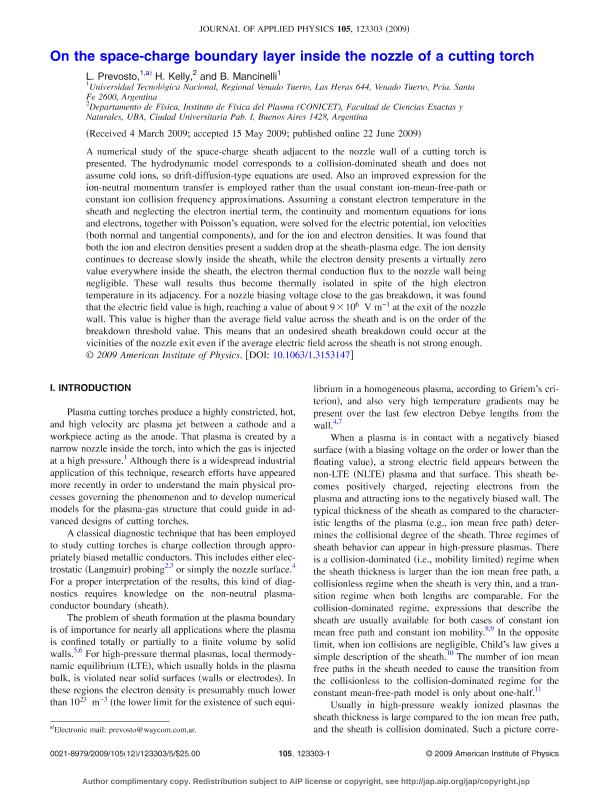Artículo
On the space-charge boundary layer inside the nozzle of a cutting torch
Fecha de publicación:
12/2009
Editorial:
American Institute of Physics
Revista:
Journal of Applied Physics
ISSN:
0021-8979
Idioma:
Inglés
Tipo de recurso:
Artículo publicado
Clasificación temática:
Resumen
A numerical study of the space-charge sheath adjacent to the nozzle wall of a cutting torch is presented. The hydrodynamic model corresponds to a collision-dominated sheath and does not assume cold ions, so drift-diffusion-type equations are used. Also an improved expression for the ion-neutral momentum transfer is employed rather than the usual constant ion-mean-free-path or constant ion collision frequency approximations. Assuming a constant electron temperature in the sheath and neglecting the electron inertial term, the continuity and momentum equations for ions and electrons, together with Poisson's equation, were solved for the electric potential, ion velocities (both normal and tangential components), and for the ion and electron densities. It was found that both the ion and electron densities present a sudden drop at the sheath-plasma edge. The ion density continues to decrease slowly inside the sheath, while the electron density presents a virtually zero value everywhere inside the sheath, the electron thermal conduction flux to the nozzle wall being negligible. These wall results thus become thermally isolated in spite of the high electron temperature in its adjacency. For a nozzle biasing voltage close to the gas breakdown, it was found that the electric field value is high, reaching a value of about 9× 106 V m-1 at the exit of the nozzle wall. This value is higher than the average field value across the sheath and is on the order of the breakdown threshold value. This means that an undesired sheath breakdown could occur at the vicinities of the nozzle exit even if the average electric field across the sheath is not strong enough. © 2009 American Institute of Physics.
Palabras clave:
Boundary Layer
,
Nozzle
,
Cutting Torch
Archivos asociados
Licencia
Identificadores
Colecciones
Articulos(INFINA)
Articulos de INST.DE FISICA DEL PLASMA
Articulos de INST.DE FISICA DEL PLASMA
Citación
Prevosto, Leandro; Kelly, Hector Juan; Mancinelli, Beatriz Rosa; On the space-charge boundary layer inside the nozzle of a cutting torch; American Institute of Physics; Journal of Applied Physics; 105; 12; 12-2009; 123303-123308
Compartir
Altmétricas




